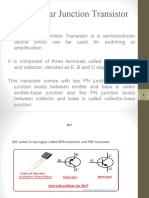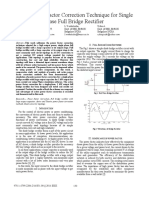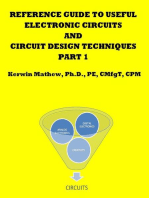0 ratings0% found this document useful (0 votes)
BJT As Amplifier - 2023
BJT As Amplifier - 2023
Uploaded by
Samer SeifThis document discusses the common emitter circuit configuration for bipolar junction transistors. It covers key topics such as the common emitter schematic, regions of operation, DC biasing, amplifier models, gain equations, and the importance of proper biasing for linear amplification. Transistors must be biased at a quiescent point to accurately amplify input signals at the output without saturation or cutoff. The common emitter configuration provides high current gain due to its relationship between the beta and alpha amplification factors.
Copyright:
© All Rights Reserved
Available Formats
Download as PDF, TXT or read online from Scribd
Download as pdf or txt
BJT As Amplifier - 2023
BJT As Amplifier - 2023
Uploaded by
Samer Seif0 ratings0% found this document useful (0 votes)
This document discusses the common emitter circuit configuration for bipolar junction transistors. It covers key topics such as the common emitter schematic, regions of operation, DC biasing, amplifier models, gain equations, and the importance of proper biasing for linear amplification. Transistors must be biased at a quiescent point to accurately amplify input signals at the output without saturation or cutoff. The common emitter configuration provides high current gain due to its relationship between the beta and alpha amplification factors.
Original Title
BJT As amplifier_2023
Copyright
© © All Rights Reserved
Available Formats
PDF, TXT or read online from Scribd
Share this document
Did you find this document useful?
Is this content inappropriate?
This document discusses the common emitter circuit configuration for bipolar junction transistors. It covers key topics such as the common emitter schematic, regions of operation, DC biasing, amplifier models, gain equations, and the importance of proper biasing for linear amplification. Transistors must be biased at a quiescent point to accurately amplify input signals at the output without saturation or cutoff. The common emitter configuration provides high current gain due to its relationship between the beta and alpha amplification factors.
Copyright:
© All Rights Reserved
Available Formats
Download as PDF, TXT or read online from Scribd
Download as pdf or txt
0 ratings0% found this document useful (0 votes)
BJT As Amplifier - 2023
BJT As Amplifier - 2023
Uploaded by
Samer SeifThis document discusses the common emitter circuit configuration for bipolar junction transistors. It covers key topics such as the common emitter schematic, regions of operation, DC biasing, amplifier models, gain equations, and the importance of proper biasing for linear amplification. Transistors must be biased at a quiescent point to accurately amplify input signals at the output without saturation or cutoff. The common emitter configuration provides high current gain due to its relationship between the beta and alpha amplification factors.
Copyright:
© All Rights Reserved
Available Formats
Download as PDF, TXT or read online from Scribd
Download as pdf or txt
You are on page 1/ 19
Electronic Circuits (ELE_112)
Power Engineering Program
Dr Ayman Elshabrawy M Ahmed Date : 26/4/2022
Common Emitter Circuit Schematic
Regions of Operation
DC Bias Circuit
• The required to work in active region
• 𝛽𝛽 = 99
• 𝑉𝑉𝐵𝐵𝐵𝐵 = 0.7𝑉𝑉
• 𝐼𝐼𝐸𝐸 = 2.5𝑚𝑚𝑚𝑚
• 𝐼𝐼𝐵𝐵1 = 19𝐼𝐼𝐵𝐵
Common Emitter Circuit Schematic
• Examine the AC behavior of BJT
Amplifier Model
• gm = transconductance
I-V Characteristic
i = gm*vin
CE Amplifier
I-V Characteristics
Gain Equation
Common Emitter Connection
• In this circuit arrangement, input is
applied between base and emitter
and output is taken from the collector
and emitter.
• Base current amplification factor (β).
• In common emitter connection, input
current is IB and output current is IC.
• The ratio of change in collector
current (Δ IC) to the change in base
current (Δ IB) is known as base current
amplification factor
Common Emitter Connection
• Relation between β and α. A simple relation between β and α can be derived as
follows:
• As α approaches unity, β approaches infinity. i.e., the current gain in common
emitter connection is very high. It is due to this reason that this circuit
arrangement is used in about 90 to 95 percent of all transistor applications.
Common Collector Connection
• In this circuit arrangement, input is applied
between base and collector while output is taken
between the emitter and collector.
• (i) Current amplification factor γ. In common
collector circuit, input current is the base current
IB and output current is the emitter current IE.
• The ratio of change in emitter current (ΔIE) to the
change in base current (ΔIB) is known as current
amplification factor in common collector
arrangement.
• This circuit provides about the same current gain
as the common emitter circuit as Δ IE ≈ Δ IC.
However, its voltage gain is always less than 1.
Relation between γ and α
Transistor as an Amplifier in CE Arrangement
• Note that a battery VBB is connected in the input circuit in addition
to the signal voltage. This dc voltage is known as bias voltage and its
magnitude is such that it always keeps the emitter- base junction
forward biased regardless of the polarity of the signal source.
Operation
• During the positive half-cycle of the signal, the forward bias across
the emitter-base junction is increased.
• Therefore, more electrons flow from the emitter to the collector via
the base. This causes an increase in collector current.
• The increased collector current produces a greater voltage drop
across the collector load resistance RC.
• During the negative half-cycle of the signal, the forward bias across
emitter base junction is decreased.
• Therefore, collector current decreases. This results in the decreased
output voltage (in the opposite direction). Hence, an amplified
output is obtained across the load.
DC Load Line and Q-Point
• A transistor must be properly biased with a dc voltage in order to operate as a
linear amplifier.
• A dc operating point Q-point (quiescent point) must be set so that signal
variations at the input terminal are amplified and accurately reproduced at the
output terminal.
Importance of Biasing
• Bias establishes the dc operating point (Q-point) for proper linear operation of an
amplifier. If an amplifier is not biased with correct dc voltages on the input and
output, it can go into saturation or cutoff when an input signal is applied.
Linear operation: larger output Nonlinear operation:
has same shape as input except output voltage limited
that it is inverted. (clipped) by cutoff
You might also like
- BJT Amplifiers: Group: ZU059 Teacher: Arzu Ibrahimova Students: Nazirli Ismat, Sadygov Baylar Subject: ElectronicsNo ratings yetBJT Amplifiers: Group: ZU059 Teacher: Arzu Ibrahimova Students: Nazirli Ismat, Sadygov Baylar Subject: Electronics19 pages
- ECE 334 Chapter 5 Biopolar Small Signal Transistors100% (1)ECE 334 Chapter 5 Biopolar Small Signal Transistors9 pages
- Electronics-I.1 - Chapter 8 BJT Common Transistors Connection ConfigurationsNo ratings yetElectronics-I.1 - Chapter 8 BJT Common Transistors Connection Configurations46 pages
- Small-Signal Modeling and Linear AmplificationNo ratings yetSmall-Signal Modeling and Linear Amplification30 pages
- Common Emitter Transistor Amplifier BasicsNo ratings yetCommon Emitter Transistor Amplifier Basics9 pages
- MCE 202 Electronics Deivices and Circuits II UpdNo ratings yetMCE 202 Electronics Deivices and Circuits II Upd69 pages
- Transistors: Bipolar Junction Transistors (BJT)No ratings yetTransistors: Bipolar Junction Transistors (BJT)32 pages
- Design & Analysis of Interleaved Boost Convertor For Renewable Energy SourcesNo ratings yetDesign & Analysis of Interleaved Boost Convertor For Renewable Energy Sources18 pages
- E-Note 12138 Content Document 20231030103638AMNo ratings yetE-Note 12138 Content Document 20231030103638AM23 pages
- Best Unit-Ii: Civil Engineering (Vi Sem)No ratings yetBest Unit-Ii: Civil Engineering (Vi Sem)54 pages
- FALLSEM2020-21 ECE2002 ETH VL2020210101764 Reference Material I 03-Sep-2020 Class A Power Amplifiers PDFNo ratings yetFALLSEM2020-21 ECE2002 ETH VL2020210101764 Reference Material I 03-Sep-2020 Class A Power Amplifiers PDF17 pages
- Small-Signal Modeling and Linear AmplificationNo ratings yetSmall-Signal Modeling and Linear Amplification30 pages
- Chap 3 - Part 3 - BJT Ac Analysis - Esb & VDBNo ratings yetChap 3 - Part 3 - BJT Ac Analysis - Esb & VDB48 pages
- Ppt-Chapter 2-BJTappli and Feedback AmpliNo ratings yetPpt-Chapter 2-BJTappli and Feedback Ampli81 pages
- 18CSS201J Analog and Digital ElectronicsNo ratings yet18CSS201J Analog and Digital Electronics34 pages
- Small-Signal Modeling and Linear AmplificationNo ratings yetSmall-Signal Modeling and Linear Amplification30 pages
- Bipolar Junction Transistor PPT - RemovedNo ratings yetBipolar Junction Transistor PPT - Removed12 pages
- Active Power Factor Correction Technique For Single Phase Full Bridge RectifierNo ratings yetActive Power Factor Correction Technique For Single Phase Full Bridge Rectifier6 pages
- Bipolar Junction Transistors (BJTS) : Electronic Devices Conventional Current Version Seventh Edition FloydNo ratings yetBipolar Junction Transistors (BJTS) : Electronic Devices Conventional Current Version Seventh Edition Floyd63 pages
- Chapter-5 Diode circuits and transistorNo ratings yetChapter-5 Diode circuits and transistor27 pages
- Small-Signal Modeling and Linear AmplificationNo ratings yetSmall-Signal Modeling and Linear Amplification30 pages
- Reference Guide To Useful Electronic Circuits And Circuit Design Techniques - Part 1From EverandReference Guide To Useful Electronic Circuits And Circuit Design Techniques - Part 12.5/5 (3)
- Reference Guide To Useful Electronic Circuits And Circuit Design Techniques - Part 2From EverandReference Guide To Useful Electronic Circuits And Circuit Design Techniques - Part 2No ratings yet
- STEM: Science, Technology, Engineering and Maths Principles Teachers Pack V10From EverandSTEM: Science, Technology, Engineering and Maths Principles Teachers Pack V10No ratings yet
- Materials Today: Proceedings: S. Nagendharan, R. Kishore, P. Gurusamy, P. SubashNo ratings yetMaterials Today: Proceedings: S. Nagendharan, R. Kishore, P. Gurusamy, P. Subash6 pages
- 9x9 Sudoku Puzzle by Printablecreative-1No ratings yet9x9 Sudoku Puzzle by Printablecreative-12 pages
- 9 - UGM2008-Berlin Implementing - APC - Deethanizer - C3Splitter - Unit - BorealisNo ratings yet9 - UGM2008-Berlin Implementing - APC - Deethanizer - C3Splitter - Unit - Borealis25 pages
- www.ijemr.net_DOC_EarthquakeVibrationControlUsingModifiedFramedShearWall422-432No ratings yetwww.ijemr.net_DOC_EarthquakeVibrationControlUsingModifiedFramedShearWall422-43212 pages
- Allama Iqbal Open University, Islamabad (Department of English Language & Applied Linguistics) WarningNo ratings yetAllama Iqbal Open University, Islamabad (Department of English Language & Applied Linguistics) Warning4 pages
- Heat Capacity and Entropy of Ni2SiO4-olivine From 5 To 1000k and Heat Capacity of Co2SiO4No ratings yetHeat Capacity and Entropy of Ni2SiO4-olivine From 5 To 1000k and Heat Capacity of Co2SiO46 pages
- Physics 9702 Paper 2 - Forces Density and PressureNo ratings yetPhysics 9702 Paper 2 - Forces Density and Pressure43 pages
- Annexure-1 - SDC Ministry of Electronics & Information Technology MEITYNo ratings yetAnnexure-1 - SDC Ministry of Electronics & Information Technology MEITY11 pages
- A New Approach To Improve Reservoir Modeling Via Machine LearningNo ratings yetA New Approach To Improve Reservoir Modeling Via Machine Learning6 pages
- Mock Interview Rubric: Interviewer Student 4 3 2 1No ratings yetMock Interview Rubric: Interviewer Student 4 3 2 11 page
- Model Bisnis Kanvas Sebagai Solusi Inovasi Bagi Yang Kecil BisnisNo ratings yetModel Bisnis Kanvas Sebagai Solusi Inovasi Bagi Yang Kecil Bisnis7 pages
- Estimating Daily Domestic Hot-Water Use in North American HomesNo ratings yetEstimating Daily Domestic Hot-Water Use in North American Homes15 pages
- BJT Amplifiers: Group: ZU059 Teacher: Arzu Ibrahimova Students: Nazirli Ismat, Sadygov Baylar Subject: ElectronicsBJT Amplifiers: Group: ZU059 Teacher: Arzu Ibrahimova Students: Nazirli Ismat, Sadygov Baylar Subject: Electronics
- ECE 334 Chapter 5 Biopolar Small Signal TransistorsECE 334 Chapter 5 Biopolar Small Signal Transistors
- Electronics-I.1 - Chapter 8 BJT Common Transistors Connection ConfigurationsElectronics-I.1 - Chapter 8 BJT Common Transistors Connection Configurations
- Design & Analysis of Interleaved Boost Convertor For Renewable Energy SourcesDesign & Analysis of Interleaved Boost Convertor For Renewable Energy Sources
- FALLSEM2020-21 ECE2002 ETH VL2020210101764 Reference Material I 03-Sep-2020 Class A Power Amplifiers PDFFALLSEM2020-21 ECE2002 ETH VL2020210101764 Reference Material I 03-Sep-2020 Class A Power Amplifiers PDF
- Active Power Factor Correction Technique For Single Phase Full Bridge RectifierActive Power Factor Correction Technique For Single Phase Full Bridge Rectifier
- Bipolar Junction Transistors (BJTS) : Electronic Devices Conventional Current Version Seventh Edition FloydBipolar Junction Transistors (BJTS) : Electronic Devices Conventional Current Version Seventh Edition Floyd
- Reference Guide To Useful Electronic Circuits And Circuit Design Techniques - Part 1From EverandReference Guide To Useful Electronic Circuits And Circuit Design Techniques - Part 1
- Reference Guide To Useful Electronic Circuits And Circuit Design Techniques - Part 2From EverandReference Guide To Useful Electronic Circuits And Circuit Design Techniques - Part 2
- STEM: Science, Technology, Engineering and Maths Principles Teachers Pack V10From EverandSTEM: Science, Technology, Engineering and Maths Principles Teachers Pack V10
- Analog Dialogue, Volume 45, Number 2: Analog Dialogue, #2From EverandAnalog Dialogue, Volume 45, Number 2: Analog Dialogue, #2
- Analog Dialogue, Volume 48, Number 1: Analog Dialogue, #13From EverandAnalog Dialogue, Volume 48, Number 1: Analog Dialogue, #13
- Materials Today: Proceedings: S. Nagendharan, R. Kishore, P. Gurusamy, P. SubashMaterials Today: Proceedings: S. Nagendharan, R. Kishore, P. Gurusamy, P. Subash
- 9 - UGM2008-Berlin Implementing - APC - Deethanizer - C3Splitter - Unit - Borealis9 - UGM2008-Berlin Implementing - APC - Deethanizer - C3Splitter - Unit - Borealis
- www.ijemr.net_DOC_EarthquakeVibrationControlUsingModifiedFramedShearWall422-432www.ijemr.net_DOC_EarthquakeVibrationControlUsingModifiedFramedShearWall422-432
- Allama Iqbal Open University, Islamabad (Department of English Language & Applied Linguistics) WarningAllama Iqbal Open University, Islamabad (Department of English Language & Applied Linguistics) Warning
- Heat Capacity and Entropy of Ni2SiO4-olivine From 5 To 1000k and Heat Capacity of Co2SiO4Heat Capacity and Entropy of Ni2SiO4-olivine From 5 To 1000k and Heat Capacity of Co2SiO4
- Physics 9702 Paper 2 - Forces Density and PressurePhysics 9702 Paper 2 - Forces Density and Pressure
- Annexure-1 - SDC Ministry of Electronics & Information Technology MEITYAnnexure-1 - SDC Ministry of Electronics & Information Technology MEITY
- A New Approach To Improve Reservoir Modeling Via Machine LearningA New Approach To Improve Reservoir Modeling Via Machine Learning
- Mock Interview Rubric: Interviewer Student 4 3 2 1Mock Interview Rubric: Interviewer Student 4 3 2 1
- Model Bisnis Kanvas Sebagai Solusi Inovasi Bagi Yang Kecil BisnisModel Bisnis Kanvas Sebagai Solusi Inovasi Bagi Yang Kecil Bisnis
- Estimating Daily Domestic Hot-Water Use in North American HomesEstimating Daily Domestic Hot-Water Use in North American Homes

























































































